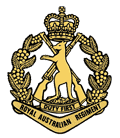|
3rd Battalion Royal Australian Regiment
Your FaithfullyJapan - Korea - Malaya - Borneo - Vietnam - East Timor - Solomons - Iraq - Afghanistan |
3rd Battalion
|
|
Echo of a soldier's death |
|
By Brendan Nicholson DEFENCE CORRESPONDENT
|
|
THE death of Lance Corporal Mason Edwards in a live-fire army exercise echoed an earlier tragedy in which one bullet would ultimately kill two young Australian soldiers and close friends. Private Adrian Cave and his mate, Private Nicholas Shiels, proudly wore paratrooper shoulder flashes as members of an elite army battalion and the dangerous exercise with live ammunition was just part of their training. Shiels fired the shot that killed Cave on May 26, 1992, in an accident at the army's training ground at Cultana in South Australia. That is where Lance Corporal Edwards, 30, was shot in the head this week during an exercise in which troops were again using live ammunition. The men were practising clearing buildings of insurgents. After the latest tragedy, the Defence Force rushed a trauma team to the commando unit to help the soldiers cope with their mate's death. His parents, Paul, a former naval officer, and Toni, said their son was already deeply traumatised and the second confrontation with live ammunition made matters much worse. A top neurologist told them the accidental shooting had caused him to develop severe depression and anxiety. He remained deeply distressed about his friend's death and told his parents memories of the incident stopped him sleeping. Unable to cope and, in the view of specialists clearly suffering from post-traumatic stress, he killed himself in December 1996. Yesterday Mr and Mrs Shiels pleaded with the Australian Defence Force to stop live-firing exercises and to ensure the soldiers involved in the latest death received the necessary care and treatment. After the accident, the Chief of Army, Lieutenant-General Ken Gillespie, said: ''From the lessons we've learnt about accidents like this … we need to insert what we call a critical incident support team and that team is a free-form organisation. ''It can include doctors, padres, psychologists, it can include friends of the people who were there or other professionals who have lived through the same sort of activity. ''So we will assemble … what's necessary to deal with the circumstances that we find.'' An ADF spokeswoman said last night that live-fire range practices involving the movement of troops were conducted to prepare soldiers for the rigours of combat. ''Live-fire range practices allow soldiers to build confidence in themselves and their team, their weapons and their tactics, techniques and procedures,'' she said. She said that since 1992, there had been three deaths in live-fire training. Lieutenant-General Gillespie said the soldiers were being trained to react instantly if they came under fire while searching buildings and compounds. He said such mission rehearsals saved lives on operations. |
|
 |
| The 3 RAR Internet site gratefully acknowledges the assistance of 101 design of Wollongong. www.101design.com.au |
